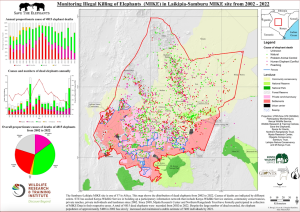The most reliable continental measure of poaching pressure is the Monitoring of Illegal Killing of Elephants (MIKE) programme, established by the UN Convention on International Trade in Endangered Species (CITES). There are around 50 MIKE sites across Africa.
The Samburu-Laikipia MIKE site in Kenya is the most data-rich on the continent, and is coordinated by Save the Elephants. Every elephant carcass that is heard about is visited by either our team or one of our partners and cause of death assessed. One measure that results from the MIKE program, the ‘Proportion of Illegally Killed Elephants’ (PIKE), gives an index of poaching pressure that is independent of the resources put into detection of carcasses.
In 2012, 72% of dead elephants had been poached, indicating crisis-levels of poaching and a population in steep decline. By 2014 this had been reduced to 48%, a level at which births exceed deaths, and in the first quarter of 2015 the PIKE was reduced to 37% – a level that it had not descended to since before the crisis hit the area.
Save The Elephants and Kenya Wildlife Service (KWS) have been collaborating with CITES on their monitoring illegal killing and hunting of elephants project since 2002. STE coordinates MIKE harmonisation meetings to collate elephant mortality statistics with numerous partners in both Samburu-Laikipia and the Masai Mara including the Northern Rangelands Trust, Lewa Wildlife Conservancy, the Samburu Trust, Space for Giants and the Mara Elephant Project.





